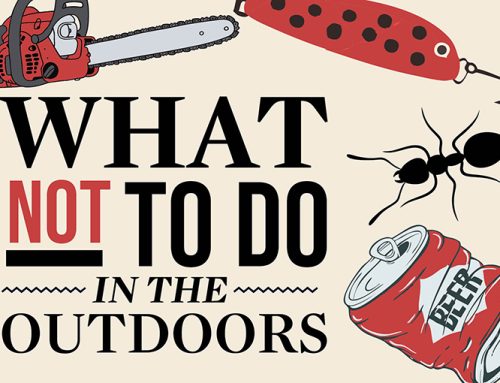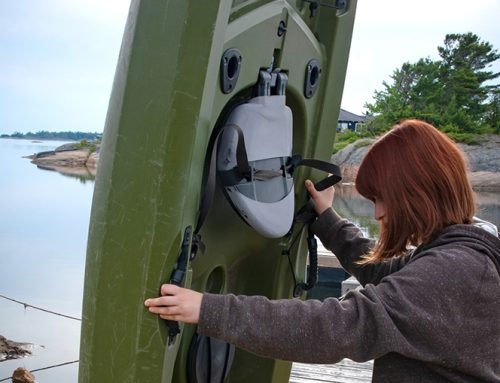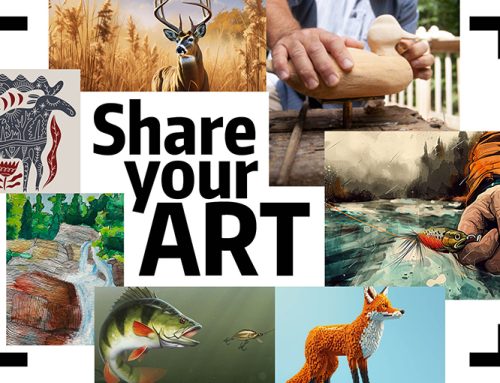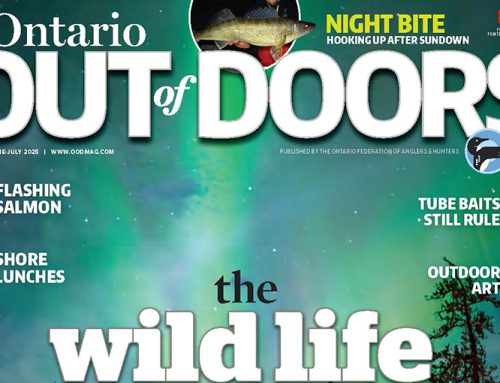
A cacophony came downwind across the water as geese and mallards fed heavily on zebra mussels before flying out to fields of newly harvested corn. We watched a leeward point on a distant island as daylight dawned. When about half of the flock seen at first light remained, we darted across 200 yards of open water to the point, scattering birds in long lines.
I pitched six goose decoys and an equal number of duck decoys in the sheltered leeside water and took to cover on the edge of the cedars. Within moments, the first squadron of mallards began to return, followed by the resonant calls of approaching goose flocks.
Fat, late fall birds
Once the easy hunting action diminished, we set up the remaining decoys, put the cover on the blind and pecked our way to a satisfying limit of fat, late fall birds, on their return from the cornfields.
The duck and goose trap is a way of thinking about maximizing shooting opportunities by bringing geese and ducks into range over water. The trap encourages innovation and experimentation, tempered with biology.
In a typical hunting situation, hunters arrive before first light, disturbing local birds that leave in darkness, and may not return to the hunters. I often wait until 9 a.m. or later, when most of the birds have departed for the fields, to choose where I will set up. I usually opt for a goose-roosting site that has not been disturbed by early morning hunters. These safe havens are remembered and used by mallards and geese upon their return from the fields.
Over the years, the trap has changed the way I think about hunting ducks and geese, making my choices more adaptive to the availability of birds and weather conditions. I used to set up just for ducks or geese, but now my focus is usually on both.
Pick your decoys
While a field hunter will set up goose decoys as family groups, the overwater shooter is limited by the number of large, unwieldy decoys one can fit into a boat. On most overwater hunts, I take out between three and 12 oversized Big Foot Goose floater decoys, and as many as 24 mallards, and a few diver duck decoys depending upon what species are around.
Decoy capacity limitations and the abundance of birds figure into my choice. If I find a good late-season mallard shoot, I will stock up on mallards and take a minimum number of goose decoys. Likewise, if the opportunity is more of a potential goose hunt, I will favour more goose decoys.
Experimenting socially
Since geese and ducks are social animals, I have experimented on how social interactions enhance the attractiveness of small, overwater decoy set-ups. Putting out two goose decoys might be the least attractive option, as two birds would indicate to other geese that they are a mated pair, and less apt to have an interest in meeting new birds. Pairs of Canadas without offspring are prone to flying around the marsh with plenty of calling, but they are far less interested in joining flocks than single birds, or pairs with one or more young birds in tow.
Adding a third decoy creates a more interesting situation for a social bird to find unmated company. Using five goose decoys seems to attract attention, without cramping mallard decoys. I place three upwind, and two approximately eight to 10 feet downwind.
When focusing more on geese, I may use a full dozen goose decoys, or up to 18 or 20 top-quality floaters. There is no doubt on most days that more goose or duck decoys is better, if they are high-quality imitations, properly positioned and have the benefit of a fair wind to keep them moving.
Here’s the situation
The following five scenarios are frequently encountered by waterfowlers across Ontario.
These habitat types are typical of overwater decoy set-ups. I have opted for fewer duck and goose decoys in these illustrations, to focus on smaller, but higher-quality deceptions in every aspect of the craft. Hunters can scale up their rigs with more decoys, but over water, there are very real limitations to set-ups based mainly on decoy numbers, unless you opt for a two- boat system. On the other hand, 18 to 20 good-quality decoys, coupled with location, great calling, good cover, and an understanding of the birds, can create the most memorable duck and goose traps.
Leading edge of cover
The leading edge of cover is most often long stands of cattails along marshy shores in lakes and rivers. Ducks follow this cover edge when looking for a roosting site or the company of other birds. Small points, inside turns, and other features that interrupt the flow of edge cover often attract birds.
Cattail islands
Cattail islands provide opportunities to get under passing birds as they traverse a marsh. They are particularly effective as cover and wind-breaks in open-water environments. Cattails in higher locations morph into scrubby bushes and long grass.
Points
Waterfowlers get up early to claim these prime spots. Points extending out into the water often have good footing for managing decoys and picking up birds. Cattail points provide good cover further from shore than the surrounding land, offering better opportunities at closer range.
Deep backwaters
These are open areas that lie between the outer limit of a marsh and the shallow water that holds feeding and roosting sites. They are often havens for mallards and also used by Canadas, if there is sufficient open water for geese to monitor potential predators, and get a running start at takeoff.
Lake/river island
This cover type is found in shield country and is used as feeding and resting locations often encountered on big-water islands and in large rivers. The shoreline may be granite, supporting bushes and dense stands of shoreline cedars. These areas situated near deep water are among the last to freeze, providing spectacular end of year hunts.
Originally published in the August 2024 issue of Ontario OUT of DOORS
For more on waterfowl, click here
Click here for more outdoors news






Leave A Comment